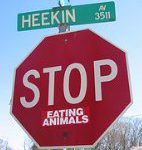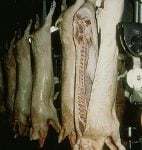There’s certainly a lot green in front of us: glistening mounds of fried Szechuan green beans, steaming Chinese broccoli and soy protein, and a small mountain of sliced celery, cucumber and bok choy-topped crispy noodles marinating in savoury broth. Carrots, onions, garlic, ginger, black mushrooms, brown rice, eggplant and tofu add to the culinary colour spectrum.
What’s missing is meat, or any animal product, for that matter. Loving Hut, in San Francisco, is a fully vegan restaurant; its menu is free of red meat, fish, poultry, eggs, dairy, even honey. With hundreds of locations in over two-dozen countries on four continents, Loving Hut claims to be the fastest-growing vegan restaurant chain in the world.
Six months ago, a Loving Hut in the Guomao district of Beijing had become one of my favorite eateries in China, and I’m curious how an American version compares. At first glance the similarities are striking. Both locations boast bright, immaculate interiors attended by friendly staff, with discreet stacks of literature expounding the benefits of a vegan diet. The menus look similar too, though San Francisco can’t quite match bargain lunch specials for 10 yuan (US$1.50).
The California locale also focuses a bit more on vegetables dishes, while its cousin in Beijing relies heavily on fake meat made from soy and wheat gluten, even adding descriptions like “beef” and “fish”. Menu diversity is apparently one of the hallmarks of Loving Hut, with each franchise owner encouraged to experiment to suit local tastes, although Chinese-themed concoctions are generally included worldwide.
My girlfriend Susan Tu – an educator raised on authentic Chinese and Vietnamese delicacies in the suburbs of Los Angeles and with a passion for pork — agreed to accompany me on a sampling of vegetarian and vegan restaurants in the San Francisco area. So far we haven’t been disappointed. The food has all been good, some has been great, and it’s made more delicious by the hope that we’re making a small contribution towards improving our personal and planetary health.
My first experiences with vegetarianism came early. I grew up on a small farm in northern California, surrounded by animals of all shapes and sizes. Some ended up on the dinner table, while others begged for scraps below. Our household was divided by diet. On one side was my grandmother, an unapologetic carnivore descended from a long line of farming pioneers. But my mother did most of the cooking, and several years before my birth she’d decided to eliminate meat from her diet entirely. The result was home cooking that tended towards vegetarian, though I was permitted to indulge meaty impulses on occasion.
In college I decided to give full vegetarianism a go, inspired as much by curiosity as underlying ideology, and spurred on by the vibrant vegetarian cooperative housing scene at Stanford University. In one of two fully vegetarian campus houses, I lived with a menagerie of idealists from diverse socioeconomic and international backgrounds, united by a veggie diet and desire to make the world a better place.
My vegetarian journey lasted three and a half years. Then a combination of competitive rugby and involvement in meat production on my family’s farm nudged me back towards being a carnivore. I also began to work and travel internationally, and often felt rude turning down local dishes because of self-imposed dietary guidelines.
But my travels and current teaching position at Stanford have also made me acutely aware of facts that make meat less appetising. For one, livestock is responsible for nearly a fifth of greenhouse-gas emissions, with a serving of beef having nearly 25 times the climate impact as the same amount of calories from vegetables and rice. I’ve also seen agriculture encroaching into natural ecosystems in Asia, Africa and the Americas, and know that deforestation and other environmental degradation linked to animal products will continue as long as populations grow — particularly if rising incomes in developing countries lead to more daily meat-eating.
So realising my own eating habits leave a bit to be desired in the realm of sustainability, I’ve been tempted to give vegetarianism another try. I’m lucky to be in San Francisco, where the city’s creative culinary tradition makes abstaining from meat relatively easy and delicious. Susan and I have sampled vegetarian options spanning a broad swathe of global cuisine and affordability.
Asian choices are plentiful, for example — from fusion restaurants (like Loving Hut) to Indian, Pakistani, Indonesian, Thai, Cambodian, Burmese, Korean, Japanese and Chinese options. The large local Buddhist population has spawned several fully vegan Chinese restaurants, where chefs also refrain from cooking with garlic and onions.
And there are Mediterranean and African options. Susan developed a particular fondness for overstuffed Lebanese falafel wraps, while I’ve found Senegalese mafé tofu, smothered in peanut sauce, to be just the thing to awaken tired taste buds. For less adventurous souls, there’s always the veggie burger or the vegan sausage.
People we talked with had chosen veggie food for a variety of often interconnected reasons: animal welfare, personal health, weight loss, religious or spiritual beliefs, reduced resource consumption and environmental degradation, global malnutrition and cost effectiveness. Some had experienced profound moments of dietary awaking. For my mother, the tipping point came while milking her cow. An overwhelming feeling of love and connectedness made eating the flesh of another sentient creature seem suddenly repulsive, despite the fact she’d already spent more than two decades raising animals for slaughter.
But can giving up meat really save our planet, as the Loving Hut slogan – “Be Veg, Go Green 2 Save the Planet” — proclaims? Over 3% of Americans now classify themselves as vegetarian, while a bit less than 1% identify as vegan, and these percentages are growing, according to Vegetarian Resource Group. But the average American or European still consumes two to 15 times as much meat per year as their neighbours in the rest of the world, and rapidly growing economies like China and Brazil are catching up fast.
So while each strict vegetarian substantially reduces personal environmental damage, it seems unlikely a wave of meat-free eating will usher in a new era of Ecotopia. With better scientific understanding of the complex communicative and emotional lives led by other species, future generations may someday look at eating factory-farmed meat in the same way as we now view cannibalism, slavery and gender inequality — but that culture shift has yet to harness much momentum.
What has been gaining traction, though, is a campaign to eat fewer animal products and to be conscious of where they come from, particularly high-impact meats like beef. Mindful meat consumption is a much easier sell for most people than eliminating it entirely, and it’s a mantra that Susan and I are trying to incorporate into our own lives, practicing omnivorous flexibility that honours culinary traditions while enhancing net sustainability.
Less meat may sound like the easy way out, but it’s a tactic that can have real impact. University of Chicago research suggests that if each American reduced his or her meat consumption just 20%, it would be equivalent to everyone in the country switching from a standard sedan to an ultra-efficient hybrid-electric vehicle. With veggie cuisine as enticing as what we ingested during our gastronomical tour of San Francisco, your taste buds might even welcome the change.
Ian Monroe is a visiting scholar and lecturer at Stanford University, where he teaches courses that explore social and environmental trade-offs linked to climate-change decisions.
Homepage image by gnohz


